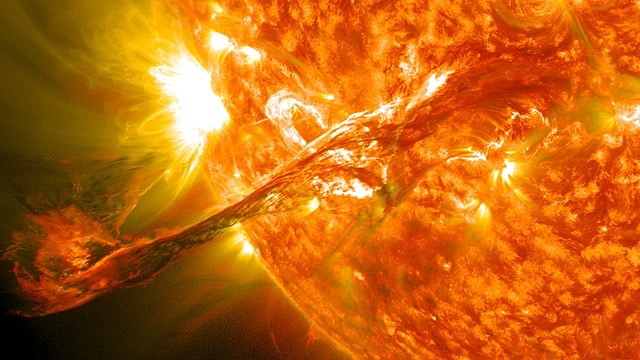Giant Solar Filament Erupts in Space
A stunning solar event has captured the attention of astronomers worldwide after a 600,000-mile-long filament of plasma erupted from the Sun’s surface earlier this week. The solar filament—longer than the distance between Earth and the Moon—was ejected into space on May 12, 2025, in a spectacular display of solar energy. Though this eruption is not directly Earth-facing, experts are closely monitoring its implications, as such events can disrupt satellites, power grids, and radio communications when aimed at our planet.
This latest eruption reminds us of the incredible power of our star and the ongoing need to monitor space weather, which has increasingly critical effects on modern technology.
What Is a Solar Filament? Understanding the Phenomenon
Solar filaments are massive arcs of cooler, denser gas suspended above the Sun’s surface by magnetic forces. When stable, they appear as dark streaks against the bright solar disk. However, when destabilized—often by shifting magnetic fields—they can explode outward in a phenomenon known as a coronal mass ejection (CME).
In this case, the filament stretched more than 600,000 miles (about 1 million kilometers), more than twice the distance between Earth and the Moon. The eruption originated from the Sun’s northern hemisphere and hurled a vast amount of plasma and magnetic energy into space.
Was Earth at Risk? CME Trajectory Explained
Fortunately, the CME from this eruption was not directed toward Earth. Scientists at NASA and the National Oceanic and Atmospheric Administration (NOAA) have confirmed that the plasma burst traveled away from our planet, posing no direct risk to satellites, GPS systems, or power infrastructure.
However, experts caution that such events serve as critical reminders of how quickly conditions can change in space weather. A similar eruption on a different trajectory could have triggered geomagnetic storms—disturbances in Earth’s magnetosphere that can disrupt everything from airline navigation systems to internet connectivity.
Potential Impacts of Earth-Directed Solar Eruptions
If a solar eruption of this magnitude were Earth-facing, the effects could be significant. Here’s what might happen:
- Geomagnetic Storms: These disturbances can overload power grids, potentially leading to widespread blackouts.
- Satellite Disruption: GPS, communication, and weather satellites can be damaged or knocked offline.
- Radiation Exposure: Astronauts and high-altitude flights may face elevated radiation risks.
- Auroras: A dazzling upside—solar storms often produce breathtaking auroras, or Northern and Southern Lights, visible much farther from the poles.
Solar Cycle 25: A Period of High Activity
This eruption is part of a broader trend. The Sun is currently in Solar Cycle 25, a roughly 11-year phase of increased sunspot activity and solar storms. Solar activity is expected to peak between 2025 and 2026, meaning events like this 600,000-mile filament could become more common—and potentially more dangerous.
NASA and other space agencies use satellites like the Solar Dynamics Observatory (SDO) to monitor the Sun in real-time. These tools allow scientists to detect solar storms early and issue warnings to industries that may be affected.
How Scientists Monitor and Predict Space Weather
Advanced satellites such as NASA’s SDO, the European Space Agency’s Solar Orbiter, and NOAA’s DSCOVR are equipped with instruments that observe the Sun’s surface and detect CMEs, flares, and solar wind variations.
Forecasting space weather is still a developing science, but improvements in real-time monitoring have helped reduce the impact of solar events on Earth’s infrastructure. For instance, operators of electrical grids and satellite systems can take preemptive measures when severe space weather is predicted.
Public Safety: Should You Be Concerned?
While this eruption poses no immediate danger, the event serves as an educational moment. Understanding space weather and its effects on everyday life—from power outages to GPS glitches—is more important than ever as society becomes more reliant on space-based technologies.
Preparedness can make a significant difference. Agencies like NOAA regularly issue space weather alerts, and governments have begun integrating solar storm response plans into broader emergency frameworks.
Conclusion: The Power of the Sun on Display
The 600,000-mile solar filament eruption may not be a direct threat, but it offers a powerful reminder of the Sun’s immense energy and its potential to affect Earth. As we move deeper into Solar Cycle 25, keeping an eye on the skies isn’t just for astronomers—it’s a matter of global infrastructure, safety, and science.
The recent eruption is a visually awe-inspiring event, and for scientists, it’s another step toward understanding—and preparing for—the immense power of our nearest star.
FAQs
1. What is a coronal mass ejection (CME)?
A CME is a massive burst of solar wind and magnetic fields rising above the solar corona or being released into space. It can cause geomagnetic storms if it reaches Earth.
2. How big was this solar eruption?
The filament was about 600,000 miles long—over twice the distance between the Earth and the Moon.
3. Will it affect Earth?
No. The eruption was not directed at Earth, so it poses no immediate threat.
4. What could happen if a similar eruption was Earth-facing?
It could disrupt satellites, power grids, and communication systems and pose radiation risks to astronauts and high-altitude flights.
5. Is solar activity increasing?
Yes. The Sun is currently approaching the peak of Solar Cycle 25, expected in 2025–2026, which brings more frequent and intense solar activity.



